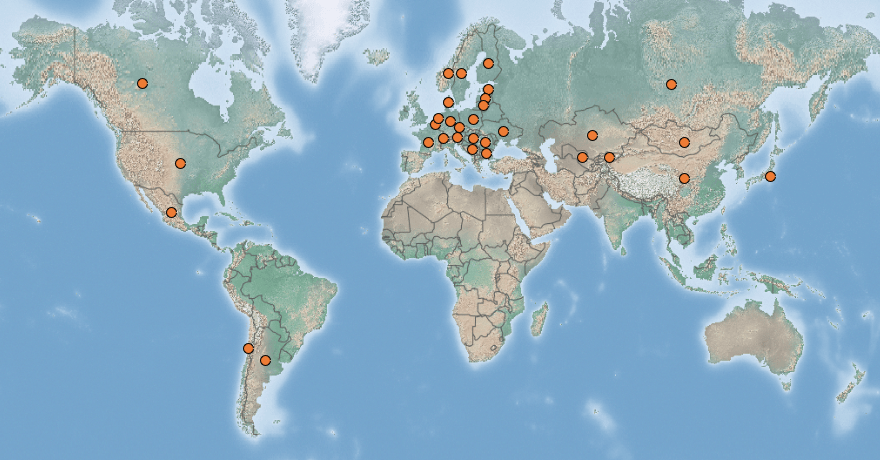 |
Muskrat | Status LU: established. 1st record: 1954. |
 |
Bisamrat | Status Eur.: established. IAS of EU concern (2017). |
 |
Rat musqué | RA: ISEIA: B3, Watch List. Harmonia+: n/a. |
 |
Bisamratte | Wikipedia:     | Wikispecies: | Wikispecies:  | CABI | CABI |
 |
Muskusrat | Back to the list of vertebrates |
Contents
Report the species
→ Report Ondatra zibethicus to the National Museum of Natural History.
Brief description
Overgrazing by muskrats can cause the local extinction of aquatic plants and the destruction of reed beds and of fish nursery areas. Due to its burrowing activity, the species degrades river banks and affects river flow. It can exert a strong predation pressure and threaten freshwater mussel and crustacean populations. It could also act as a reservoir for different pathologies and causes damage to agriculture. The muskrat is included in the appendix under recommendation no 77 of the Council of Europe as a species which has proved to be a threat to biological diversity and for which eradication is strongly recommended (Branquart et al. 2011).
IAS of Union concern
In 2017, Ondatra zibethicus L. was added to the list of invasive alien species of Union concern (Anonymous 2017) which implies that member states shall take all necessary steps to prevent it’s unintentional introduction or spread.
Status and distribution in Luxembourg
Records of Ondatra zibethicus Linnaeus, 1766 in Luxembourg. Data source: Recorder-Lux, iNaturalist & GBIF, 2024-10-22.
The first documented occurrence of Ondatra zibethicus L. in Luxembourg dates from 1954. It was found by zoologist Joseph Hoffmann (1911-2000) on 17th August 1954 in the resected meander named “Al Mudder” near Pettingen, Municipality of Mersch (Heuertz 1957: 43; MNHNL 2000-). The invasion originated in the Lorraine Moselle. Since then, the species has spread and has achieved a nationwide distribution (Schley & Herr 2019: 168).
In 2024, 419 observations of species in Luxembourg are accessible through the MNHNL-mdata portal (MNHNL, iNaturalist & GBIF 2024).
Historical note: because of the threat of an invasion from the Belgian-Dutch border, where the muskrat had escaped from farms, the Luxembourg Water and Forest Directorate issued a grand ducal decree on 17 December 1930 prohibiting, inter alia, its import to or its transport in the grand duchy (Heuertz 1957: 46-47).
Management
Action plan
An action plan concerning the muskrat has been published in 2020:
→ Finalised Action Plan for Ondatra zibethicus (De Sousa & Lestang 2020)
Risk assessment
ISEIA protocol
B3 (3+3+3+1) = Watch List (Ries et al. 2014: 199).
Harmonia+ protocol
Not assessed yet.
Fact sheet
PDF fact sheet of the Nature and Forestry Administration: FR | DE
Worldwide distribution
Bibliography
- Anonymous, 2017. Commission implementing regulation (EU) 2017/1263 of 12 July 2017 updating the list of invasive alien species of Union concern established by Implementing Regulation (EU) 2016/1141 pursuant to Regulation (EU) No 1143/2014 of the European Parliament and of the Council. Official Journal of the European Union L 182: 37-39 (13.7.2017).
- Branquart, E., M. D’aes, B. Manet, G. Motte, V. Schockert & J. Stuyck, 2011. Harmonia database: Ondatra zibethicus L.. Harmonia version 1.2, Belgian Forum on Invasive Species. URL: http://ias.biodiversity.be [accessed on 2019-10-28]
- CABI, 2009. Ondatra zibethicus L. [original text by Patrick Triplet]. In: Invasive Species Compendium. Wallingford, UK: CAB International. URL: www.cabi.org/isc [accessed 2020-02-04]
- De Sousa, T. & L. Lestang, 2020. Plan d’action pour espèces exotiques envahissantes au Grand-Duché de Luxembourg: le Rat musqué, Ondatra zibethicus (Linnaeus, 1766). Version 2020-09-04. Administration de la nature et des forêts, Luxembourg. 21 pp.
- Heuertz, M., 1957. Premières captures de rats musqués (Ondatra zibethicus L.) au grand-duché de Luxembourg. Archives de la section des sciences de l’Institut grand-ducal N.S. 24: 41-51.
- MNHNL, 2000-. Ondatra zibethicus L. in Recorder-Lux, database on the natural heritage of the Grand Duchy of Luxembourg. Musée national d’histoire naturelle, Luxembourg. URL: https://mdata.mnhn.lu [Accessed 2020-02-04]
- MNHNL, iNaturalist & GBIF, 2019. Ondatra zibethicus L. in MNHNL-mdata, online portal combining species observation from Recorder-Lux, iNaturalist and GBIF. National Museum of Natural History, Luxembourg. URL: https://mdata.mnhn.lu [Accessed 2020-02-04]
- Naturverwaltung (ed.), 2013. Jagbare Wildtierarten Luxemburgs. 96 pp.
- Pir, J.B. & L. Schley, 2015. Développement des connaissances sur la répartition et l’écologie des mammifères au Luxembourg entre 1990 et 2015. Bull. Soc. Nat. luxemb. 116: 437-455.
- Ries, C., M. Pfeiffenschneider, Engel, E., J.-C. Heidt & M. Lauff, 2014. Environmental impact assessment and black, watch and alert list classification after the ISEIA Protocol of vertebrates in Luxembourg. Bull. Soc. Nat. luxemb. 115: 195-201. [PDF 247 KB]
- Schley, L., C. Schanck, M. Schaul & C. Sinner, 2001. Neubürger und Heimkehrer unter den Wildtieren Luxemburgs. Beiträge zur Jagd- und Wildforschung 26: 141-154.
- Schley, L. & J. Herr, 2019. Säugetiere Luxemburgs. Hrsg.: natur&ëmwelt a.s.b.l., Ministère du développement durable et des infrastructures, Administration de la nature et des forêts. 219 S. ISBN 978-2-9199511-0-9 [French edition: Les mammifères du Luxembourg, ISBN 978-2-9199511-2-3]
Suggested citation of this webpage
Ries, C. & M. Pfeiffenschneider (Eds.), 2024. Ondatra zibethicus (Linnaeus, 1766). In: neobiota.lu - Invasive Alien Species in Luxembourg. National Museum of Natural History, Luxembourg. URL: https://neobiota.lu/ondatra-zibethicus/ [Accessed 2024-10-22].
Page content last updated on 2024-07-31. Last proofread by Caroline Grounds on 2019-11-28.


